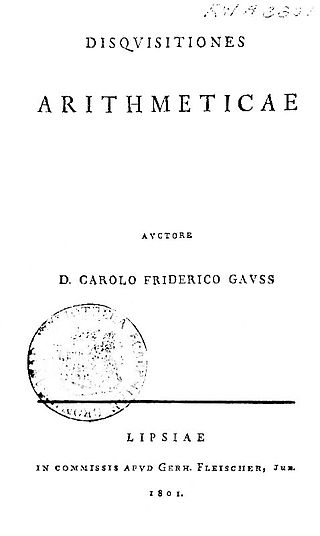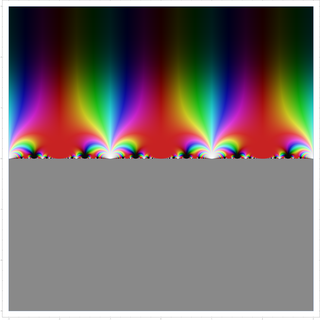
Complex analysis, traditionally known as the theory of functions of a complex variable, is the branch of mathematical analysis that investigates functions of complex numbers. It is helpful in many branches of mathematics, including algebraic geometry, number theory, analytic combinatorics, and applied mathematics, as well as in physics, including the branches of hydrodynamics, thermodynamics, quantum mechanics, and twistor theory. By extension, use of complex analysis also has applications in engineering fields such as nuclear, aerospace, mechanical and electrical engineering.

In number theory, the law of quadratic reciprocity is a theorem about modular arithmetic that gives conditions for the solvability of quadratic equations modulo prime numbers. Due to its subtlety, it has many formulations, but the most standard statement is:
In mathematics, a modular form is a (complex) analytic function on the upper half-plane, , that satisfies:

In mathematics, the Weierstrass elliptic functions are elliptic functions that take a particularly simple form. They are named for Karl Weierstrass. This class of functions are also referred to as ℘-functions and they are usually denoted by the symbol ℘, a uniquely fancy script p. They play an important role in the theory of elliptic functions, i.e., meromorphic functions that are doubly periodic. A ℘-function together with its derivative can be used to parameterize elliptic curves and they generate the field of elliptic functions with respect to a given period lattice.
In mathematics, integral equations are equations in which an unknown function appears under an integral sign. In mathematical notation, integral equations may thus be expressed as being of the form: where is an integral operator acting on u. Hence, integral equations may be viewed as the analog to differential equations where instead of the equation involving derivatives, the equation contains integrals. A direct comparison can be seen with the mathematical form of the general integral equation above with the general form of a differential equation which may be expressed as follows:where may be viewed as a differential operator of order i. Due to this close connection between differential and integral equations, one can often convert between the two. For example, one method of solving a boundary value problem is by converting the differential equation with its boundary conditions into an integral equation and solving the integral equation. In addition, because one can convert between the two, differential equations in physics such as Maxwell's equations often have an analog integral and differential form. See also, for example, Green's function and Fredholm theory.
In mathematics, complex multiplication (CM) is the theory of elliptic curves E that have an endomorphism ring larger than the integers. Put another way, it contains the theory of elliptic functions with extra symmetries, such as are visible when the period lattice is the Gaussian integer lattice or Eisenstein integer lattice.
In probability theory and related fields, Malliavin calculus is a set of mathematical techniques and ideas that extend the mathematical field of calculus of variations from deterministic functions to stochastic processes. In particular, it allows the computation of derivatives of random variables. Malliavin calculus is also called the stochastic calculus of variations. P. Malliavin first initiated the calculus on infinite dimensional space. Then, the significant contributors such as S. Kusuoka, D. Stroock, J-M. Bismut, Shinzo Watanabe, I. Shigekawa, and so on finally completed the foundations.
In mathematics, the Weierstrass functions are special functions of a complex variable that are auxiliary to the Weierstrass elliptic function. They are named for Karl Weierstrass. The relation between the sigma, zeta, and functions is analogous to that between the sine, cotangent, and squared cosecant functions: the logarithmic derivative of the sine is the cotangent, whose derivative is negative the squared cosecant.
In mathematics, the fundamental theorem of Galois theory is a result that describes the structure of certain types of field extensions in relation to groups. It was proved by Évariste Galois in his development of Galois theory.
In mathematics, the Fredholm alternative, named after Ivar Fredholm, is one of Fredholm's theorems and is a result in Fredholm theory. It may be expressed in several ways, as a theorem of linear algebra, a theorem of integral equations, or as a theorem on Fredholm operators. Part of the result states that a non-zero complex number in the spectrum of a compact operator is an eigenvalue.
In physics and mathematics, the Gibbs measure, named after Josiah Willard Gibbs, is a probability measure frequently seen in many problems of probability theory and statistical mechanics. It is a generalization of the canonical ensemble to infinite systems. The canonical ensemble gives the probability of the system X being in state x as
Cubic reciprocity is a collection of theorems in elementary and algebraic number theory that state conditions under which the congruence x3 ≡ p (mod q) is solvable; the word "reciprocity" comes from the form of the main theorem, which states that if p and q are primary numbers in the ring of Eisenstein integers, both coprime to 3, the congruence x3 ≡ p is solvable if and only if x3 ≡ q is solvable.
In mathematics, Lindelöf's theorem is a result in complex analysis named after the Finnish mathematician Ernst Leonard Lindelöf. It states that a holomorphic function on a half-strip in the complex plane that is bounded on the boundary of the strip and does not grow "too fast" in the unbounded direction of the strip must remain bounded on the whole strip. The result is useful in the study of the Riemann zeta function, and is a special case of the Phragmén–Lindelöf principle. Also, see Hadamard three-lines theorem.
In mathematics, the Abel–Jacobi map is a construction of algebraic geometry which relates an algebraic curve to its Jacobian variety. In Riemannian geometry, it is a more general construction mapping a manifold to its Jacobi torus. The name derives from the theorem of Abel and Jacobi that two effective divisors are linearly equivalent if and only if they are indistinguishable under the Abel–Jacobi map.

In mathematics, the modular lambda function λ(τ) is a highly symmetric Holomorphic function on the complex upper half-plane. It is invariant under the fractional linear action of the congruence group Γ(2), and generates the function field of the corresponding quotient, i.e., it is a Hauptmodul for the modular curve X(2). Over any point τ, its value can be described as a cross ratio of the branch points of a ramified double cover of the projective line by the elliptic curve , where the map is defined as the quotient by the [−1] involution.
In mathematics, the moduli stack of elliptic curves, denoted as or , is an algebraic stack over classifying elliptic curves. Note that it is a special case of the moduli stack of algebraic curves . In particular its points with values in some field correspond to elliptic curves over the field, and more generally morphisms from a scheme to it correspond to elliptic curves over . The construction of this space spans over a century because of the various generalizations of elliptic curves as the field has developed. All of these generalizations are contained in .

In mathematics, the Dixon elliptic functions sm and cm are two elliptic functions that map from each regular hexagon in a hexagonal tiling to the whole complex plane. Because these functions satisfy the identity , as real functions they parametrize the cubic Fermat curve , just as the trigonometric functions sine and cosine parametrize the unit circle .
In mathematics Abel elliptic functions are a special kind of elliptic functions, that were established by the Norwegian mathematician Niels Henrik Abel. He published his paper "Recherches sur les Fonctions elliptiques" in Crelle's Journal in 1827. It was the first work on elliptic functions that was actually published. Abel's work on elliptic functions also influenced Jacobi's studies of elliptic functions, whose 1829 published book "Fundamenta nova theoriae functionum ellipticarum" became the standard work on elliptic functions.
The Fokas method, or unified transform, is an algorithmic procedure for analysing boundary value problems for linear partial differential equations and for an important class of nonlinear PDEs belonging to the so-called integrable systems. It is named after Greek mathematician Athanassios S. Fokas.
In mathematics, calculus on Euclidean space is a generalization of calculus of functions in one or several variables to calculus of functions on Euclidean space as well as a finite-dimensional real vector space. This calculus is also known as advanced calculus, especially in the United States. It is similar to multivariable calculus but is somewhat more sophisticated in that it uses linear algebra more extensively and covers some concepts from differential geometry such as differential forms and Stokes' formula in terms of differential forms. This extensive use of linear algebra also allows a natural generalization of multivariable calculus to calculus on Banach spaces or topological vector spaces.



















































